

Committee on the Environment Chooses This Year’s Top Ten Green Projects
To mark Earth Day 2004, April 22, the AIA and its Committee on the Environment selected 10 examples of green design that protect and enhance the environment. The top 10 projects will be honored in June at the AIA National Convention in Chicago.
The selected projects address significant environmental challenges with designs that integrate architecture, technology, and natural systems. The top 10 projects make a positive contribution to their communities, set examples for future development, improve comfort for building occupants, and reduce environmental impacts through strategies such as: reuse of existing structures, connection to transit systems, low-impact site development, energy and water conservation, and use of “green” construction materials. Several of the projects reclaim former brownfield sites.
The seventh annual AIA/COTE Top Ten Green Projects initiative was developed in partnership with the U.S. Department of Energy, Environmental Building News magazine, and the U.S. Environmental Protection Agency ENERGY STAR™ program.
Jury members say they wanted to pick a range of project and building types. The application forms gave them 10 metrics on each project for a quick reading on performance. “Then the text had to show that the submitter knew what he or she was talking about,” they said. “This was not a beauty parade, although a lot of the submissions are really good contenders for AIA Honor Awards.” The panel of jurors included: Tony McLaughlin; Sandra Mendler, AIA; William Rees Morrish; M. Susan Ubbelohde; and Donald Watson, FAIA.
Following are the 2004 Top Ten Green Projects:
20 River Terrace—The Solaire, New
York City, by Cesar Pelli & Associates Architects
“The architect set a high agenda
in terms of bringing sustainability and social responsibility to a mainstream
project in a competitive market.”
—COTE Top Ten jury.
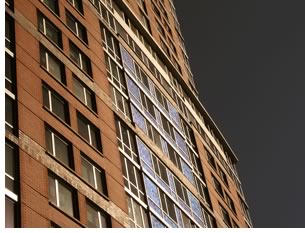 20
River Terrace is a 27-story, glass-and-brick residential tower in Battery
Park City, directly adjacent to the site of the former World Trade Center,
meeting both the recently enacted New York State Green Building Tax Credit
and Gold LEED™ Certification. The architect designed the 357,000-square-foot,
293-unit building to consume 35 percent less energy, reduce peak demand
for electricity by 65 percent, require 50 percent less potable water,
and provide a healthy indoor environment. An integrated array of photovoltaic
panels generates 5 percent of the building’s energy at peak loading.
The building incorporates an advanced HVAC system, fueled by natural gas
and free of ozone-depleting refrigerants. Daylighting has been maximized,
and high-performance casement windows were used throughout. All residential
units include programmable digital thermostats, Energy Star™ fixtures,
and a master shutoff switch.
20
River Terrace is a 27-story, glass-and-brick residential tower in Battery
Park City, directly adjacent to the site of the former World Trade Center,
meeting both the recently enacted New York State Green Building Tax Credit
and Gold LEED™ Certification. The architect designed the 357,000-square-foot,
293-unit building to consume 35 percent less energy, reduce peak demand
for electricity by 65 percent, require 50 percent less potable water,
and provide a healthy indoor environment. An integrated array of photovoltaic
panels generates 5 percent of the building’s energy at peak loading.
The building incorporates an advanced HVAC system, fueled by natural gas
and free of ozone-depleting refrigerants. Daylighting has been maximized,
and high-performance casement windows were used throughout. All residential
units include programmable digital thermostats, Energy Star™ fixtures,
and a master shutoff switch.
Photo © Jeff Goldberg/Esto
Environmental Services Building, Pierce
County, Wash., by The Miller/Hull Partnership
“A brownfield site becomes a benchmark
for future buildings as the design team applies nontraditional daylighting
strategies to create interior spaces that are very humane and sophisticated.”
—COTE Top Ten jury.
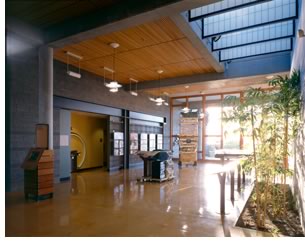 This
building sits on a 900+ acre site, much of which has been extensively
mined for gravel for over 100 years, resulting in a barren landscape.
As the first major building constructed under “Reclaiming Our Resources,”
the county’s 50-year master plan for the site, it sets the tone
for future development. Its driving concepts call for a more humane work
environment, introduction of natural light, interior vegetation, and views
to the exterior. The project attempts to make people aware of being part
of a greater regional context by developing the “Mt. Rainier”
axis through the site. Space planning follows a European office model:
No desk is more than 30 feet to a window. Extensive daylighting studies
led to the use of baffles in the skylights, a large western overhang,
and exterior sunscreens on the east façade. A raised-floor air
distribution system reduces the size and energy consumption of the mechanical
system, improves indoor air quality, provides for future flexibility,
and gives individuals direct control of their immediate environment. Nighttime
flushing lowers the temperature of the concrete structure by several degrees,
resulting in “free” cooling at the beginning of the day.
This
building sits on a 900+ acre site, much of which has been extensively
mined for gravel for over 100 years, resulting in a barren landscape.
As the first major building constructed under “Reclaiming Our Resources,”
the county’s 50-year master plan for the site, it sets the tone
for future development. Its driving concepts call for a more humane work
environment, introduction of natural light, interior vegetation, and views
to the exterior. The project attempts to make people aware of being part
of a greater regional context by developing the “Mt. Rainier”
axis through the site. Space planning follows a European office model:
No desk is more than 30 feet to a window. Extensive daylighting studies
led to the use of baffles in the skylights, a large western overhang,
and exterior sunscreens on the east façade. A raised-floor air
distribution system reduces the size and energy consumption of the mechanical
system, improves indoor air quality, provides for future flexibility,
and gives individuals direct control of their immediate environment. Nighttime
flushing lowers the temperature of the concrete structure by several degrees,
resulting in “free” cooling at the beginning of the day.
Photo © Eckert & Eckert
Factor 10 House, Chicago, by EHDD Architecture
“In a grassroots movement toward
sustainability, the Chicago Housing Authority has built its first affordable
housing cooled passively without central air conditioning, helping to
lead the building community, including the major retail stores, to these
concepts.”
—COTE Top Ten jury.
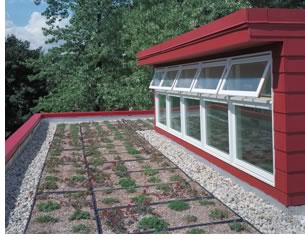 Factor
10 House’s cutting edge design was one of five affordable case-study
designs chosen in the City of Chicago departments of Environment and Housing
2000 national competition to identify creative modifications to the existing
New Homes for Chicago program. F10’s modular design responds to
a narrow city site with adjacent buildings with an open 1,800-square-foot
floor plan that incorporates a solar chimney in the stairwell. The open
plan enhances cross ventilation. Window placement maximizes reflected
light; the solar chimney includes a south-facing clerestory window that
brings natural light to the house’s core. A high-efficiency gas-fired
boiler and perimeter baseboard ducts provide heating, while natural ventilation
delivers the cooling. A wall of water bottles acts as a heat sink in winter.
Factor
10 House’s cutting edge design was one of five affordable case-study
designs chosen in the City of Chicago departments of Environment and Housing
2000 national competition to identify creative modifications to the existing
New Homes for Chicago program. F10’s modular design responds to
a narrow city site with adjacent buildings with an open 1,800-square-foot
floor plan that incorporates a solar chimney in the stairwell. The open
plan enhances cross ventilation. Window placement maximizes reflected
light; the solar chimney includes a south-facing clerestory window that
brings natural light to the house’s core. A high-efficiency gas-fired
boiler and perimeter baseboard ducts provide heating, while natural ventilation
delivers the cooling. A wall of water bottles acts as a heat sink in winter.
Photo © Doug Snower Photography
Genzyme Center, Cambridge, Mass., by Behnisch,
Behnisch & Partner Inc.
“The corporation invested heavily
to make this great piece of architecture a model for corporate offices
in the coming decade, with its sophisticated glazing, lighting, and mechanical
systems that create a growing, active place supportive of its occupants.”
—COTE Top Ten jury.
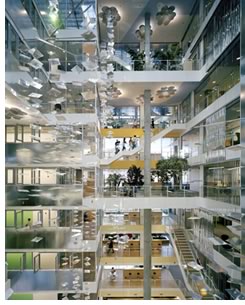 The
building, headquarters for a biotechnology company, sits on a former brownfield
site in Cambridge at Kendall Square, a dense, massive “1970s Urban
Renewal” development project built on wetlands fill. All of the
environmental design strategies—energy efficiency, water conservation,
material selection, urban site selection, and indoor environmental quality—not
only contribute to the Platinum LEED rating the building is expected to
achieve from the U.S. Green Building Council—but establish an open
spatial atmosphere for the building occupants. The high-performance curtain-wall
system boasts operable windows on all 12 floors. These windows, linked
to the building management system, allow for automated control and “night
cooling.” Also, a third of the exterior envelope is a ventilated
double façade with a four-foot buffer that tempers solar gains
year round. The building’s central atrium space acts as a huge return
air duct and light shaft, and steam from a nearby power plant supplies
central heating and cooling. The building will also use 32 percent less
water than a comparable office building by having waterless urinals, dual-flush
toilets, automatic faucets and low-flow fixtures.
The
building, headquarters for a biotechnology company, sits on a former brownfield
site in Cambridge at Kendall Square, a dense, massive “1970s Urban
Renewal” development project built on wetlands fill. All of the
environmental design strategies—energy efficiency, water conservation,
material selection, urban site selection, and indoor environmental quality—not
only contribute to the Platinum LEED rating the building is expected to
achieve from the U.S. Green Building Council—but establish an open
spatial atmosphere for the building occupants. The high-performance curtain-wall
system boasts operable windows on all 12 floors. These windows, linked
to the building management system, allow for automated control and “night
cooling.” Also, a third of the exterior envelope is a ventilated
double façade with a four-foot buffer that tempers solar gains
year round. The building’s central atrium space acts as a huge return
air duct and light shaft, and steam from a nearby power plant supplies
central heating and cooling. The building will also use 32 percent less
water than a comparable office building by having waterless urinals, dual-flush
toilets, automatic faucets and low-flow fixtures.
Photo © Anton Grassl
Greyston Bakery, Yonkers, N.Y., by Cybul
& Cybul Architects
“This is a cultural ecology where
the design team understood that a workplace is not just a box you work
in, but a quality environment to maintain workers; one in which the fundamental
processes reveal the greatest potential for energy savings.”
—COTE TOP Ten jury.
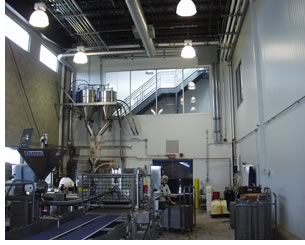 The
Greyston Bakery offers a 23,000-square-foot, state-of-the-art production
bakery on a 1.6-acre former brownfield site in an old industrial area
near downtown Yonkers. Intended as a revitalization catalyst to this blighted
neighborhood, the new bakery functions as a continuous automated machine
to produce brownies and other baked products. The building is bisected
by a three-level light shaft with translucent floors, then bisected again
in the opposite direction by a two-story atrium, which separates the office
area from the production bakery and introduces light and air into the
offices. The light shaft and atrium also allow natural airflow throughout
the bakery. Outside ambient air cools the baked products as they travel
down a continuous spiral conveyor.
The
Greyston Bakery offers a 23,000-square-foot, state-of-the-art production
bakery on a 1.6-acre former brownfield site in an old industrial area
near downtown Yonkers. Intended as a revitalization catalyst to this blighted
neighborhood, the new bakery functions as a continuous automated machine
to produce brownies and other baked products. The building is bisected
by a three-level light shaft with translucent floors, then bisected again
in the opposite direction by a two-story atrium, which separates the office
area from the production bakery and introduces light and air into the
offices. The light shaft and atrium also allow natural airflow throughout
the bakery. Outside ambient air cools the baked products as they travel
down a continuous spiral conveyor.
Photo © David Johnson and Mauricio Sanchez
Herman Miller, Zeeland, Mich., by Krueck
& Sexton Architects
“As if Saarinen had returned with
more tools and an additional 30 years’ experience in sustainable
use, good light, and air, this sweet little exposed-structure box shows
that the Top 10 is also about extending the life of existing buildings
in clever ways.”
—COTE Top Ten jury.
 At
the most fundamental level, reuse of a building is one of the most sustainable
strategies available. This project restores, revitalizes, and transforms
a classic but aging Modern building into an environmentally responsive,
high-quality workplace, exemplifying Herman Miller’s core values
of human-centered, -spirited and -purposeful design. Located on the company’s
main campus, this two-story 1974 office building housed Herman Miller’s
executives until 1997. The architect stripped the interior to structure
and replaced it with minimal finishes using 50 percent recycled content.
They also reorganized it to provide maximum daylight penetration and 100
percent line-of-sight to the landscape. With 69 percent of its total energy
produced on site, the redesign achieves a 29 percent reduction in energy
consumption over ASHRAE 90.1-1999, mainly through envelope improvements
and high-efficiency mechanical equipment and lighting. The project also
supported the regional economy, with 57 percent of construction materials
sourced within 500 miles.
At
the most fundamental level, reuse of a building is one of the most sustainable
strategies available. This project restores, revitalizes, and transforms
a classic but aging Modern building into an environmentally responsive,
high-quality workplace, exemplifying Herman Miller’s core values
of human-centered, -spirited and -purposeful design. Located on the company’s
main campus, this two-story 1974 office building housed Herman Miller’s
executives until 1997. The architect stripped the interior to structure
and replaced it with minimal finishes using 50 percent recycled content.
They also reorganized it to provide maximum daylight penetration and 100
percent line-of-sight to the landscape. With 69 percent of its total energy
produced on site, the redesign achieves a 29 percent reduction in energy
consumption over ASHRAE 90.1-1999, mainly through envelope improvements
and high-efficiency mechanical equipment and lighting. The project also
supported the regional economy, with 57 percent of construction materials
sourced within 500 miles.
Photo © Mariuz Mizera
Lake View Terrace Branch Library, Los
Angeles, by Fields Devereaux Architects & Engineers/GreenWorks
“Ample daylight without glare,
the distinguished evaporative cooling tower that greets you at the entryway,
natural ventilation, inventive use of color, careful material selection,
and outstanding views make this library wonderful.”
—COTE Top Ten jury.
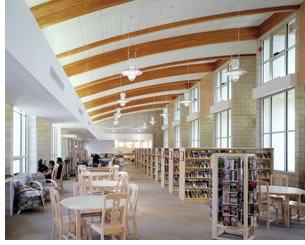 Lake
View Terrace Library, a branch multipurpose facility for the City of Los
Angeles, enjoys a spacious main reading room that stretches along the
east-west axis and dramatic views of the park to the south. The building’s
site stormwater runoff was reduced by 25 percent with landscaping features
that include a series of radial bioswales for efficient rainwater infiltration.
More than 75 percent of construction waste was diverted from landfills
to local recycling facilities. The Library’s energy performance
is more than 40 percent more efficient than California standards. Its
high-mass CMU shell sports exterior insulation to allow night venting.
Approximately 80 percent of the building is naturally ventilated via mechanically
interlocked windows controlled by the building’s energy management
system. A building-integrated photovoltaic system shades the entry and
roofs the community room while providing 15 percent of the building’s
energy. The design provides nearly 100 percent shading of glazing during
operating hours. The program called for a LEED Platinum building; it is
the first project of the city to attempt this level.
Lake
View Terrace Library, a branch multipurpose facility for the City of Los
Angeles, enjoys a spacious main reading room that stretches along the
east-west axis and dramatic views of the park to the south. The building’s
site stormwater runoff was reduced by 25 percent with landscaping features
that include a series of radial bioswales for efficient rainwater infiltration.
More than 75 percent of construction waste was diverted from landfills
to local recycling facilities. The Library’s energy performance
is more than 40 percent more efficient than California standards. Its
high-mass CMU shell sports exterior insulation to allow night venting.
Approximately 80 percent of the building is naturally ventilated via mechanically
interlocked windows controlled by the building’s energy management
system. A building-integrated photovoltaic system shades the entry and
roofs the community room while providing 15 percent of the building’s
energy. The design provides nearly 100 percent shading of glazing during
operating hours. The program called for a LEED Platinum building; it is
the first project of the city to attempt this level.
Photo © RMA Photography
The Plaza at PPL Center, Allentown, Pa.,
by Robert A.M. Stern Architects
“With a clean aesthetic in a conventional
building block, this project makes a number of nice moves—with double
envelopes, daylight, and a winter garden—to frame a public space
and contribute it to the city.”
—COTE Top Ten jury.
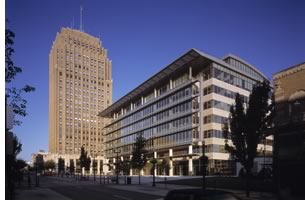 This
LEED Gold high-performance urban office building, was designed and built
in 18 months on a suburban real-estate budget ($104 per square foot hard
cost for the shell and core). The eight-story building offers Allentown’s
downtown its first new office development in over 25 years. A dramatic
eight-story glass atrium brings natural light deep into the core of the
building, while extensive perimeter glazing provides panoramic views and
abundant daylight filtered through brises-soleil directly to all building
spaces. CO2 sensors ensure that fresh air is supplied directly to each
building area as needed. A pair of two-story plant-filled winter gardens
along the south façade of the building provide unique workspaces
for the occupants, bring daylight deeper into the floor plates, control
glare, and improve indoor air quality. The building’s layout and
efficient building systems—plus use of zero-emitting or very low
VOC-emitting paint, adhesives, sealants, carpet, and composite wood—reduce
energy demand by more than 30 percent over code requirements. Water use
is 45 percent below code requirements, and construction materials contained
more than 20 percent recycled content.
This
LEED Gold high-performance urban office building, was designed and built
in 18 months on a suburban real-estate budget ($104 per square foot hard
cost for the shell and core). The eight-story building offers Allentown’s
downtown its first new office development in over 25 years. A dramatic
eight-story glass atrium brings natural light deep into the core of the
building, while extensive perimeter glazing provides panoramic views and
abundant daylight filtered through brises-soleil directly to all building
spaces. CO2 sensors ensure that fresh air is supplied directly to each
building area as needed. A pair of two-story plant-filled winter gardens
along the south façade of the building provide unique workspaces
for the occupants, bring daylight deeper into the floor plates, control
glare, and improve indoor air quality. The building’s layout and
efficient building systems—plus use of zero-emitting or very low
VOC-emitting paint, adhesives, sealants, carpet, and composite wood—reduce
energy demand by more than 30 percent over code requirements. Water use
is 45 percent below code requirements, and construction materials contained
more than 20 percent recycled content.
Photo © Peter Aaron/Esto
City of White Rock Operations Centre,
White Rock, British Columbia, by Busby + Associates Architects
“A truly sustainable building that
humans will use, cherish, and maintain over time, this collaborative achievement
succeeds at all levels: massing, use of daylight, orientation, the way
the water works on the site, and the use of materials.”
—COTE Top Ten jury.
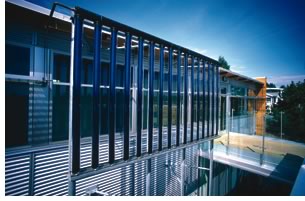 The
mandate of the City of White Rock was to make their new Operations Building
as environmentally sustainable as reasonably possible, in accordance with
the City’s own policy. The 6,545-square-foot building earned a LEED
Gold certification through a great variety of strategies that include
photovoltaic panels for electricity and solar tubes to provide base radiant
heating for the building. Daylight lightshelves reduce lighting needs.
A green sod roof reduces runoff from impermeable surfaces, while a pervious
parking allows infiltration of water into the ground. The facility also
uses stormwater rather than potable water to wash down city vehicles and
for toilets, and waterless urinals and low-flow faucets throughout the
facility further reduce water consumption. Extensive use of materials
produced within a 500-mile radius of the site also reduced transportation
effects on the environment.
The
mandate of the City of White Rock was to make their new Operations Building
as environmentally sustainable as reasonably possible, in accordance with
the City’s own policy. The 6,545-square-foot building earned a LEED
Gold certification through a great variety of strategies that include
photovoltaic panels for electricity and solar tubes to provide base radiant
heating for the building. Daylight lightshelves reduce lighting needs.
A green sod roof reduces runoff from impermeable surfaces, while a pervious
parking allows infiltration of water into the ground. The facility also
uses stormwater rather than potable water to wash down city vehicles and
for toilets, and waterless urinals and low-flow faucets throughout the
facility further reduce water consumption. Extensive use of materials
produced within a 500-mile radius of the site also reduced transportation
effects on the environment.
Photo © Colin Jewall
Woods Hole Research Center Gilman Ordway
Campus, Woods Hole, Mass., by William McDonough + Partners
“By testing and understanding how
to achieve the highest level of performance in environmentally sensitive
elements, such as water recovery and sole-source wind-turbine energy,
this building raises the bar very high for the next generation of buildings.”
—COTE Top Ten jury.
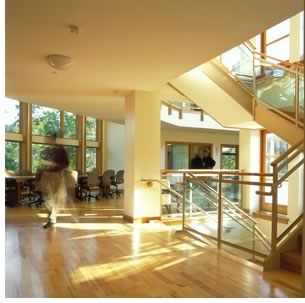 Working
within a challenging and constrained site, the design preserves the cultural
landscape represented by an existing 19th-century summer home, respectfully
and adaptively reusing the original house and adding contemporary office,
laboratory, and common spaces. The all-electric building relies on renewable
energy sources, including a grid-connected and net-metered 26.4-kW photovoltaic
array that powers the building’s closed-loop ground-source heat
pump system. A planned on-site wind turbine will likely make the building
a net-energy exporter. Icynene spray foam insulates all exterior walls
and roof assemblies, creating a technically and ecologically effective
air barrier and optimized R-values. Other components reinforce the performance
benefits of this extremely secure envelope including offset-stud framing,
double- and triple-glazed argon-insulated low-e windows, enthalpy wheels
that recapture heat and moisture from exhaust air and precondition incoming
fresh air, and high-efficiency lighting controls and occupancy monitors.
Working
within a challenging and constrained site, the design preserves the cultural
landscape represented by an existing 19th-century summer home, respectfully
and adaptively reusing the original house and adding contemporary office,
laboratory, and common spaces. The all-electric building relies on renewable
energy sources, including a grid-connected and net-metered 26.4-kW photovoltaic
array that powers the building’s closed-loop ground-source heat
pump system. A planned on-site wind turbine will likely make the building
a net-energy exporter. Icynene spray foam insulates all exterior walls
and roof assemblies, creating a technically and ecologically effective
air barrier and optimized R-values. Other components reinforce the performance
benefits of this extremely secure envelope including offset-stud framing,
double- and triple-glazed argon-insulated low-e windows, enthalpy wheels
that recapture heat and moisture from exhaust air and precondition incoming
fresh air, and high-efficiency lighting controls and occupancy monitors.
Photo © Judy Watts Wilson
Copyright 2004 The American Institute of Architects.
All rights reserved. Home Page ![]()
![]()
 |
||
| The latest EBN Archives CD is now available. This virtual green building library features 99 issues of Environmental Building News, from the very first, in 1992, though the end of 2003. The EBN Archives (version 8.0) costs $199 for new users. Owners of prior versions may upgrade for $79. Call BuildingGreen at 800-861-0954 to order or for more information, or visit their Web site.
|
||